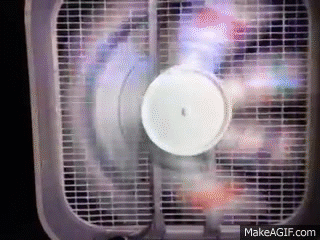Stroboscopic Rod

A rod rotates clockwise about its end 200 times per minute. This rod is kept in a dark room, and is flashed with bursts of light 201 times per minute.
How does the rod appear to move?
Note: The rate of the rod's rotation and the rate of the light flash are both constant.
This section requires Javascript.
You are seeing this because something didn't load right. We suggest you, (a) try
refreshing the page, (b) enabling javascript if it is disabled on your browser and,
finally, (c)
loading the
non-javascript version of this page
. We're sorry about the hassle.
16 solutions
wow good solution I understood it right away thanks~
doesn’t the question ask how does the flash appear to move, not the rod?
Log in to reply
yes. Poor wording.
Log in to reply
I agree! Putting the math aside for a moment, the question does specifically ask "how does the rod appear to be moving", not which direction is it actually moving. It appears to be moving clockwise.
Log in to reply
@Jackie Hemsley – We made a mistake in which we asked for the movement of the flash instead of the rod, but it has since been corrected. Sorry for the confusion!
Log in to reply
@Andrew Hayes – It should be ‘how will the rod’s movement likely be percieved'. Looking at a propeller outside the aeroplane window the last time I flew, the brain does tend automatically to lock on to one direction, but one can ‘convince’ oneself of the other direction and actually change which direction ones brain will perceive. In general, there’s nothing necessary about which option the brain has to choose, but the sought out answer to this problem is neither correct nor incorrect, but merely the best inference according to one of the easiest schemes (see my post above), according to which that the brain may categories what it sees.
Log in to reply
@R Mathe – This is approximately what the rod will look like, flashing 3 1 0 times per second and moving ≈ 2 ∘ per flash.

As you can see, it would be very unlikely that someone would perceive a clockwise motion.
Log in to reply
@Andrew Hayes – That’s exactly what I said: the qualification of the conclusion is ‘very likely’, but not necessary. The statement is not true, it’s just very probable.
We made a mistake in which we asked for the movement of the flash instead of the rod, but it has since been corrected. Sorry for the confusion!
This is rather subjective, but a sensible assumption is, if between any two moments, a rotating object is seen to advance θ ∈ [ 0 , 1 ) of an entire cycle, then
-
if
θ
=
0
then the mind perceives
no movement; -
if
0
<
θ
≪
0
,
5
then the mind perceives a (slow)
forwards movement; -
if
0
,
5
≪
θ
<
1
then
0
<
−
θ
≪
0
,
5
modulo
1
, so the mind perceives a (slow)
backwards movement. - if θ ∼ 0 , 5 , then it is not straightforward how to judge how the mind will categorise the movement, as it cannot necessarily discern between a fast forwards movement and a fast backwards movement.
We are given f 1 = 2 0 0 rpm and f 2 = 2 0 1 rpm . The ‘speed’ of the clock is f 1 and the time between subsequent flashes is δ t = f 2 1 minutes. Thus in the time between flashes, the rod advances a total of f 1 ⋅ δ t = f 2 f 1 = 9 9 , 5 0 % of a complete cycle. Based on the above criteria, the eye perceives a backwards movement of the rod.
I agree. I gave this answer and it said I was wrong...?! The explanation states I was right. Meh...
That was so cool. You know what, I confused myself then ended up forgetting that they (the rotation and the flashing) both occur in one minute. Nice shot big guy. That was AWESOME.
This is an example of the Wagon-Wheel effect . You've probably seen the illusion of when a ceiling fan moves fast enough, it appears to move backwards. This happens because the blades at one moment are a slight degree further than what your mind anticipates. A strobe light can also produce the Wagon-Wheel effect. Rotational movements appear backwards If the strobe light flashes fast enough.
Similar to the rims of a sports car,right?
Log in to reply
yes. especially visible on the wheels of high end cars.
And some good fidget spiners
I would speculate that this relates to the following property of sinusoids:
c o s ( ω 1 t ) c o s ( ω 2 t ) = 2 1 [ c o s ( ω 1 t − ω 2 t ) + c o s ( ω 1 t + ω 2 t ) ]
Suppose ω 1 is the frequency of the rod's rotation, and ω 2 is the frequency of the strobe light. If ω 2 > ω 1 , the first sinusoid on the right side rotates oppositely from the rod, and at a lower speed. So in this case, the rod rotates at 2 0 0 r p m clockwise, and the perceived image of the rod rotates at 1 r p m anticlockwise. Interestingly, there should be another component of the perceived image rotating at 4 0 1 r p m clockwise.
That is the equation for amplitude modulation. I'm not sure how amplitude may be "interpreted", maybe if we were observing a light that became brighter or dimmer depending on the position of the rod. Moreover, the strobe is not a "sinusoidal", it's a pulse so the equation of the brightness of the light turning off and then on at a different brightness would be a bit more complicated it would be the effect of modulation by an infinite series of harmonics. The slower frequency, the observation of the rod going backwards would be the "envelope" of that modulation...
Nope. The definition of „Hertz“ is „x per second“. But the frequency in the example here is „x per minute“.
Frequency of flash is greater than frequency of rod (201>200). This means when the flash is set on the rod has not completed one revolution. It has covered a little less than a revolution. This results in a relative counterclockwise motion
Similarly, I thought that about every .005 sec it returns but about every .00497sec it flashes so having not completed a return, it would seem to go backwards.
I think this is related to the beat phonomenon in sound. When two sinusoids of close frequencies overlap, they produce beats moving at a slower rate, namely f1-f2.
I welcome 'peer review' on a bonus question. I was wondering what the apparent speed of the backwards motion would be, and came to the conclusion that the bar would appear to be traveling counter-clockwise at a rate of 1 rotation per minute. And that can be generalized to say that if the flash rate is +1 over the bar rate (for ANY bar rate), then the backwards rotation will always be once per time interval. Further, I see how this can be generalized in a formula that, for any bar/flash/time, will tell you the apparent spin rate (backwards or forwards). I didn't do the extra effort to formalize the method, as I need to get back to work :)
Wouldn't we change the very nature of a particle if we try to detect it with light that has a large amount of energy? By that we won't have an accurate depiction any way..
It's a rod, not a particle.
Intuitively, you increase the rate of the flashes to decrease the apparent rotation of the rod, until it appears stationary. Therefore increasing the flash rate again will make the rod rotation appear to decrease more - move anticlockwise.
Wagon wheel effect, like in movies you see the blades of an helicopter moving slower or in a different direction.this is due to the fact that the camera takes videos in form of fast flashes,like say 5 pictures taken in one second.so if the blades move faster than the camera flashes,each time they would appear a little bit shy of their actual position.same applies to the human eye.
If the burts of light flashed the rod 200 times per minute, it would appear exactly every time the rod is in its original state (upwards pointing, "12 o' clock" direction) and disappear immeadiately, giving the impression that the rod is not moving (stationary). But since the burst of light appears 201 times per minute , each time the rod would look to be a tiny bit behind the above-mentioned original state and at each time the distance will slowly grow, giving us the impression that the rod is rotating counterclockwise.
Take a clock that turns 3 times in 3 hours. If we flash a flash light 4 times.
Each flash will be at 45 minutes, as 3 hours = 180 minutes / 4 flashes = 45 minutes until next flash.
First flash will be at 45 minutes
Second will be at 30 minutes (45*2 = 1 and 1/2 hour)
Third will be at 15 minutes (45*3 = 2 and 1/4 hour)
Last flash will be at 0 minutes (45*4 = 3 hours)
Take 200n mod 201, n being a positive integer
The frequency of the strobe is higher than that of the rotation. Each flash occurs slightly before the rod completes a revolution . I think it would complete one counter clockwise revolution for every 200 flashes.
Picture 12 o’clock (like on a watch) as the point on the rod where it starts it’s rotation. If the light flashed 200 times per minute, which is the same as the rods rate of rotation, the rod would appear stationary because when the rod gets to its 12 o’clock position, the light will flash on it, and the rest of the rods positions would be in darkness. So it would be like looking at the rod, then suddenly it appears at 12 o’clock, then darkness, then 12 o’clock and so on.
Now if the light flashed 201 times per minute, things are different. The light will flash before the rod reaches 12 o’clock on the first rotation, and so it would appear say around 11 o’clock. Because 201 times per minute slightly faster than 200, each subsequent rotation of the rod would appear slightly further counterclockwise than the last. So on the second rotation, the rod is around 10 o’clock, then 9 and so on, thus producing a counterclockwise motion. (These clock positions are made up for visualisation purposes)
its actually simple
the rod completes one rotation in 0.3 secs while the light blinks again in less than 0.3 sec let it be t
so when the light blinks again after t time the rod is about to finish its rotation(so it is seen little bit backward than its previous position)
this things happen again and the succeeding positions appears little bit backward than the original and it seems as counter clockwise

If the light was pulsing exactly 200 times per minute, then it would pulse at the exact moment that the rod finishes its rotation at each pulse. Then, the rod would appear stationary.
Since the light is pulsing at 201 times per minute, it is pulsing slightly faster than the rod's rotation. In other words, it flashes right before the rod finishes its rotation at each pulse. Given that the rod is rotating clockwise, the rod will appear rotated slightly anticlockwise at each pulse. This will give the appearance that the rod is slowly rotating anticlockwise.
Getting more specific on how this will look...
The rod rotates through 2 0 1 2 0 0 of a full rotation after the first pulse and after every pulse thereafter. This translates to 3 6 0 ∘ × 2 0 1 2 0 0 ≈ 3 5 8 ∘ of rotation.
Since this is so close to a full rotation, it appears as though the rod is rotating anticlockwise instead of clockwise.
A similar concept is used to create " holoblade " advertising devices. Instead of light shining on a rotating rod, the holoblade is a rotating rod which contains a series of lights. These lights are designed to pulse at certain intervals, giving the illusion of shape and movement.